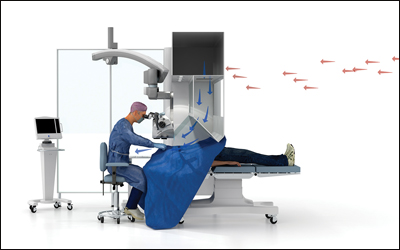Semi-mobile operating unit enhances sterility, improves patient flow and comfort
Several surgical units have been installed in the Netherlands.
A semi-mobile operating unit effectively serves clinics that need additional surgical facilities at an affordable cost, according to one surgeon.
“Operating rooms are a major investment for newly starting clinics and for clinics that need to increase their volume of surgeries. With this in mind, and for our own clinic, we developed the SurgiCube and have been using it for more than 6 years now,” Gerrit Melles, MD, told Ocular Surgery News.
SurgiCube (SurgiCube International Inc.) is a semi-mobile operating cubicle available in various sizes. It can be implemented in any pre-existing space and provides a 100% sterile environment in which small surface surgery or microsurgery can be performed.
“The laminar airflow provides ultra-clean air directly over the operating surface, the instrument table and the head of the patient, without passing contamination sources such as the operating microscope, the operating surgeon or the patient’s body,” Melles, an OSN Europe Edition Board Member, said.

Having this additional facility in a clinic offers the option to move the bulk of high-volume microsurgical interventions to an alternative treatment environment. This can relieve the overload and improve the efficiency of the main operating room, Melles said.
“While major orbital surgeries can be performed in the OR, the SurgiCube can be used for cataract surgery, intravitreal injections and even routine corneal transplantation,” he said.

Image: Melles G
The high number of intravitreal procedures is currently a burden for many clinics. They are fast and relatively simple procedures but need a sterile environment, and patients are usually moved to the OR after the routine diagnostic or monitoring examinations are performed.
“The SurgiCube saves the time of moving the patients from here to there because both the pretreatment examinations and the treatment itself can be performed in the same place,” Melles said.
In his clinic, two semi-mobile surgical units have been installed. Melles performs all of his keratoplasty procedures in these units.
“You can move from one unit to the other and be very independent from the operating room’s schedule. But the most important advantage is that you operate in a very safe, sterile environment — more sterile than the ordinary OR,” he said.
Melles noted that patients like the more informal setting. Patients, surgeons and staff do not have to dress up for surgery, and this takes away a lot of the anxiety of going through a surgical procedure.
The SurgiCube has been implemented in several clinics and university hospitals in the Netherlands and in various hospitals throughout Europe. – by Michela Cimberle
- For more information:
- Gerrit Melles, MD, can be reached at the Netherlands Institute for Innovative Ocular Surgery, Laan Op Zuid 88, 3071 AA Rotterdam, Netherlands; +31-10-297-4444; fax: +31-10-297-4440; email: melles@niios.nl.
Disclosure: Melles is a consultant for SurgiCube.
